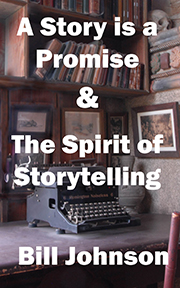| A Story is a Promise |
|
|
| Essays on the Craft of Writing |
| About the Author |
Writing a Story Synopsis
by Bill Johnson
Revised 5/3/98
The following is an abbreviated version of my essay on writing a story synopsis. The full essay is available in my workbook, A Story is a Promise, available for $15.95 plus $4 shipping and handling. This workbook guides writers to an new understanding of the craft of writing dramatic stories.
A one-page story synopsis that accurately reflects the issues at stake in a story is valuable when describing a story to agents, producers and editors.
Many writers struggle with writing a one page synopsis because they want to set out the actions of their characters. To describe a story, however, is a separate issue from writing about a character's goals or one's plot. For example, the story The Hunt for Red October is about freedom battling oppression. This is the dramatic issue at the core of the story.
To describe The Hunt For Red October, then, is not the same as talking about the actions of its main character, Ramius. A synopsis of The Hunt For Red October might begin,
"The Hunt For Red October is the story of one man's battle to be free of the system that oppresses him."
Note, the first line of the synopsis identifies what's at stake in the story, freedom battling oppression. One should avoid writing,
"The Hunt For Red October is the story of Ramius, the commander of a Soviet nuclear-missile armed submarine who uses the submarine to flee to America."
Ramius manifests the story, but the story itself is about this issue of freedom battling oppression. Because readers desire to experience this story's fulfillment, it engages their interest.
The story's synopsis should make clear what's at stake in the story itself, before introducing the story's characters.
Continuing...
"To gain his freedom, Ramius, the commander of the Soviet nuclear missile-armed submarine Red October, sets in motion a plan to escape to America."
Note that Ramius is described in relationship to what's at stake in the story, the issue of freedom. This continues the synopsis describing the story itself. One should avoid writing,
"As the story opens, Ramius, commander of the nuclear missile-armed submarine Red October, sets in motion a plan to escape to America."
This only offers a description of the story's main character, and the story's plot. It doesn't suggest the connection between Ramius' actions, the story's plot, and what's at stake in the story.
"Ramius has long hated his oppressors, the communist party that rules Russia and his native Lithuania. He's been held in check while his wife was alive. With her passing, he has no restraints on his desire to be free."
This gives a sense of why Ramius desires to be free: it is to escape the oppression of his communist masters, whom he loathes. Even though this appears to be describing Ramius, it's describing him in a way that makes clear his relationship to the story itself.
One should avoid writing,
"Ramius wants to pay back the communists for what they have done to Lithuania, his homeland."
This explains why Ramius acts, and it's true, but it doesn't tie his actions into the story's underlying premise.
The essay concludes...
When you write a synopsis for your script, it's important it communicate what is dynamic and engaging about your story, not that it appear exactly like the synopsis I've created for The Hunt for Red October. In working with students, I've found they often create a first sentence that can be too plain when they talk about their story and its premise in a concrete way. Often, the second sentence of their synopsis is the natural opening for the synopsis. For example, I recently read a first sentence for a synopsis that began (approximately; I have revised it):
"The Price is a tale of political intrigue and one man's struggle to find redemption in a corrupt world."
The second sentence of the synopsis began:
"In a world where science allows a handful of powerful people to create truth for a price, one man struggles with the worth of his soul."
This sentence is another potential opening sentence for this synopsis. It sets out the issue at the heart of this story while suggesting its plot.
Another possible opening sentence:
"Craig Bowman was a man who thought he knew the price of his soul until his was sold."
Choose the opening sentence that communicates the purpose of your story in the strongest, most engaging language.
Good luck. Writing a great synopsis can be difficult, a real art.
Top of page